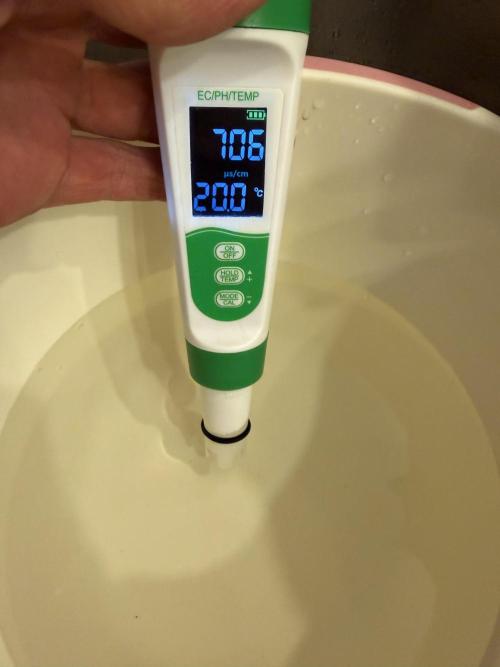The Grow Awards 2026 🏆 























Not watered for a week. Why does the soil not dry even from above?
Peresecheniestarted grow question 6y ago
Four fabric pots of 27 liters.
Below is drainage from vermiculite, above is a layer of coconut, above is soil from peat, humus, sand and perlite, purchased. In the upper layer, perlite is twice as large.
Solved
Setup. Substrates
likes
Peresechenieanswered grow question 6y ago
Rus + Eng (Google translate, sorry)
Four fabric pots of 27 liters.
Below is drainage from vermiculite, above is a layer of coconut, above is soil from peat, humus, sand and perlite, purchased. In the upper layer, perlite is twice as large.
A hose from a weak aerator is brought to the bottom.
Ventilation in the box is an active weak exhaust, a passive inflow below.
Temperature + 29-30С is stable.
Besides four bushes a little clover grows.
I decided to dry the soil for overflow prevention.
Did not water the bushes for a week.
Even on the surface, the soil is still wet.
There were no signs of overflow.
One minus - the pots are on the floor, not on the grill.
I noticed that the clover begins to die, as if withers and turns into humus.
Could this be due to fungi and bacteria in EM 1?
Why doesn't the earth dry for so long?
Is it dangerous for the roots?
Is it better to continue regular watering and top dressing, or let it dry without fertilizing, given that the third week of flowering has now begun?
Рус + Eng (Google translate, sorry)
Четыре тканевых горшка по 27 литров.
Внизу дренаж из вермикулита, выше слой кокоса, выше почва из торфоф, гумуса, песка и перлита, покупная. В верхнем слое перлита больше в два раза.
На дно подведен шланг от слабого аэратора.
Вентиляция в боксе - активная слабая вытяжка, внизу пассивный приток.
Температура +29-30С стабильно.
Помимо четырёх кустов растёт немного клевера.
Решил просушить почву для профилактики перелива.
Не поливал кусты неделю.
До сих пор даже на поверхности почва мокрая.
Признаков перелива вроде бы небыло.
Один минус - горшки стоят на полу, а не на решётке.
Заметил, что клевер начинает гибнуть, словно вянет и превращается в перегной.
Может быть это из-за грибков и бактерий в ЭМ 1?
Почему земля не сохнет так долго?
Опасно ли это для корней?
Лучше продолжить регулярный полив и подкормку, или дать ей просохнуть, не удобряя, учитывая, что сейчас началась третья неделя цветения?
Shagrathanswered grow question 6y ago
I think that you should have added perlite instead of vermiculite as drainage because vermiculite holds moisture just like coco does so now you don't really have drainage in the bottom but rather sponge that sucks up all the water.. Never grown like that but this is what first came to my mind.
Maybe you should lift the pot above ground and add fan blowing straight to the pot so it would dry out little quicker.
1 like
Complain
ijustdontgiveafanswered grow question 6y ago
27 liter pots are quite big, so they can store a lot of water, even with decent drainage.. not watering for a week at 27 liters doesn't surprise me (depending on the size of the plant).. i have smaller plants in a 3 liter pouch, and if i fully water it, so there's good runoff, it will keep moist for over a week..
I would suggest to raise the fabric pots off the ground though (if possible), so the excess water can really get out, and doesn't stay in the bottom, as the roots don't like standing water.
a temperature of up to 30 degrees i find quite high, so if it's indoor i would suggest looking into either lowering it a bit, or add co2 (as this can help the plant withstand higher temperatures).. eventually it also depends on the strain if it's meant for warmer climates or not.
1 like
Complain
Similar Grow Questions
Solved

Kianjack
Rock wool cubesHi everyone this is my first grow and I’m not the most clued up lol. Any advice appreciated.
I started in 1.5” then 3” rock wool cubes. I’m currently in week 4 , I plan to start flower at week 6 so Iv just transplanted into 6” cubes to see it right through. Will this be okay?
Setup. Substrates
4y ago
2
Solved

Kolibri
Erde ohne PerliteGibt es eine gute Erde für den Cannabisanbau, die KEINE Perlite enthält?
Canna Terra, Plagron und Biobizz enthalten offenbar in allen Mischungen Perlite, ich möchte dieses aber selbst zuführen.
Perlite bekomme ich für 9 Cent das Kilogramm (5-10L)Setup. Substrates
4y ago
1
5
Solved

majklsoft
slowly drying soil VS transplanting autoflower (Day22)bad idea to transplant my autoflowers (day 22, entering preflower) now that I’ve realized the substrate (Biobizz Lightmix) is too compacted and takes 6–8 days to dry? What else can I do? I know transplanting causes stress, but isn’t slow-drying soil an even bigger problem? thanks
Week 3
Setup. Substrates
6mo ago
15
7
Solved

PurpleDoll
White hair-like worms in runoffWhat are those little hairlike white worms in my runoff? I use mills nutrients
Are they dangerous for my plant? Is flowering now and it looks amazing
You can find them on the bottom, they look like hairs but they move
- PurpleDoll
Roots. Other
Setup. Substrates
5y ago
6
5
Solved

Lucky2Times
How does this soil mix look?What are the top natural soil additives from growers experience?
I have a pile aging, the mix so far (approx)
2 yards of mushroom compost
8 cubic feet of aged chicken and duck poo, mulch and crushed oyster shells
5 lbs of bloodbone meal
1 lb dried kelp
1 pkg mycorrhizaeWeek 1
Setup. Substrates
4y ago
4
2
Solved

BullWeedDog
he comprado este insecticida que su composición es Lambda cihalotrin y Benzisotiazol puedo utilizarlo en mis plantas??ha mi planta le esta empezando a caer mosca del mantillo y trips he comprado este insecticida pero luego de llegar a casa me he dado cuenta que no tiene piretrina, y como no es de ninguna marca especializada en cannabis quería saber si lo puedo utilizar que me dicen??
Other. Bugs
Other. General questions
Setup. Substrates
4y ago
1
1
Solved

Woodside
Advice on growing in a 5x5 tentAfter 3 attempts growing I’ve decided to invest the money in some decent equipment for a 5x5 tent,I currently have a ts3000I’m looking for help with how to ventilate the area correctly. The last 3 times I ended up with mold but used a light and tent. Advice for a set up please !Setup. Substrates
Setup. Ventilation
3y ago
2
6
Solved

Hou_Stone
Reusing soil ?For the first time I am thinking of reusing the soil from my last crop (universal soil used once. bionutrients added months ago)
I imagine making a mixture of 50% old soil and 50% new
I'm wondering if I should clean or do anything to my old soil before reusing it?
Advices? 😃☮️
Setup. Substrates
2y ago
8
6
Solved

Mooncat
Expanded clay layer on bootom for better drainageIs placing a layer of expanded clay on the botton of your pot a good idea? i only tried small rocks before for the drainage but heard those claypellets might work better (and are lighter)...
Someone any expierence with that?Other. Mold
Setup. Substrates
5y ago
1
1
Solved

Trichom420CZ
Organic living soil / Just add a waterWhat do you mean about my own recipe on organic living soil?
Basis: coco coir, compost, perlite 1/1/1 + Mycorhize
Basic nutrients: Worm hummus, Guano 4/1
Other additives: wood ash, dolomitic limestone, epsom salt, egg shells
does the mix contain everything what canna need?Setup. Substrates
2y ago
2
Solved

Spike-GreenGrower
(2nd try) Growing in Coco - organic nutrients possible or only synthetics?Can one use Organic nutrients + microbes when growing in Coco?
I have two full bottles of Alga and Bloom and don't want to toss them. My tapwater is hard enough (now with proper pic) so Ca shouldn't be a problem 😂
What would be the advantages vs disadvantages?
Plant. Other
Setup. Substrates
Setup. Other
1mo ago
16
7
Solved

Canabisius
I brought in a bin of my vegetable garden soil from last season. Very nice stuff - worms and organics, I ran some water through it ph 6.57 runoff.
** The only thing I am concerned about is these little sacs of spores or pollen ( not sure ) **
😕
Anyone have any ideas ??
Roots. Other
Setup. Substrates
5y ago
3
2
Solved

Bonkheads
Planting directly into soil with full of other roots? (Outdoor Guerilla Autoflower)The site is full of brambles with dense rootzones. I have dug a hole but its full of roots. Is it OK if I cut down every single root from my hole? Could my plant catch bacteria and etc from the brambles roots? Won't the brambles roots suck away all my nutrient from my plant?
Roots. Other
Setup. Substrates
Setup. Outdoor
3y ago
3
Solved

noobiii
I used a three gallon pot and filled it, with moist soil, to around 70% capacity. Would this soil be enough for a single Royal Gorilla Auto or Should I add more soil? If the answer is positive then how should I go about it? Any help is greatly appreciated since I am a total noob.
Plant. Other
Roots. Other
Setup. Substrates
4y ago
4
2
Solved

SickFuck76
Presoak soil?Should I presoak my Special mix soil from Gold Label?
Moving The Girls to their final 11l container.Setup. Substrates
4y ago
1
3








